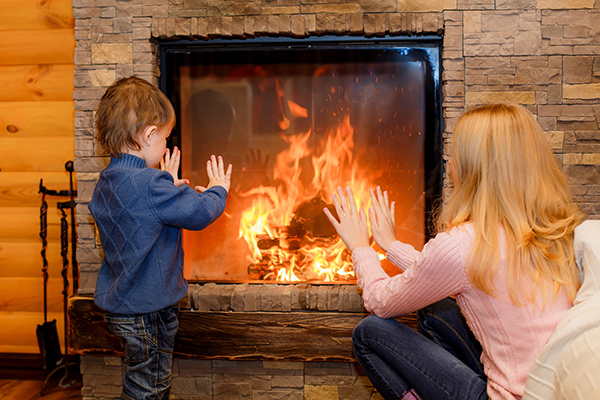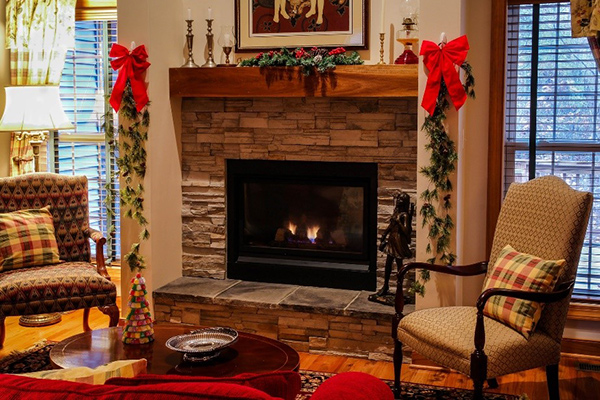
As winter swings into full force and thermometers dip past the freezing point, your home will need some help to stay warm. Most homeowners turn to their central air to keep things comfortable, but that can come with extreme costs – especially for larger homes. If you want to stay nice and toasty without the big costs, why not consider heating your home with a fireplace?
Can a Fireplace Really Heat Your Home?
Absolutely! And many houses already have a fireplace. It’s just a matter of using it to bring some much-desired warmth into your home.
That said, unlike central air, no fireplace is going to be able to properly heat your entire home at once. If your fireplace or stove are on one end of your house, don’t expect the other end to be just as warm. Even if you could generate that much heat with a fireplace, it would be far less efficient than central air due to the distance it would have to travel in your open home.
However, a fireplace can easily be used for what’s known as “zone heating.”
What is Zone Heating?
The biggest waste of energy and money with central air is through heating rooms that aren’t in use. If you turn on the heat to get warm in your living room, and then head to your bedroom to sleep, what use is there in heating every other room in your house?
Zone heating is exactly what it sounds like – heating specific areas of your home. While there are many ways to accomplish this, the simplest is to use the room in which your fireplace is built.
By using your fireplace to heat the room instead of central air, you’re limiting your energy costs to only what it takes to heat that specific room. Not only do you get to enjoy a nice, roaring fire, you’ll also realize substantial savings on your next heating bill!
What Type of Fireplace Heats a Home the Best?
There are several types of fireplaces and each product a varying amount of heat for your home.
Wood Burning Fireplaces
On its own, a wood burning fireplace is the least efficient of all fireplaces for producing heat. In most cases, it only creates a very small amount of heat.
However, due to the amount of heat that is pulled out through the chimney in a wood burning fireplace, it can surprisingly decrease the heat in your home. This happens when the low heat vents through the flue, creating airflow out the chimney. Warm air in the home is sucked into this flow and out of your home.
For these reasons, if your goal is to warm the home using a fireplace, you’ll be better off with another option.
Gas Fireplaces
While traditional wood-burning fireplaces are popular for their classic look and feel, gas fireplaces continue to be adopted by homeowners worldwide. If your home doesn’t have one, a professional can install a new gas fireplace in your home, even in place of an existing wood-burning firebox.
There are two types of gas fireplaces that you can choose from: vented or unvented.

Vented Gas Fireplaces
Operating similarly to a traditional wood-burning fireplace, vented gas fireplaces uses gas logs and at a glance look completely natural. In addition to being remotely controllable, vented gas fireplaces are extremely efficient. You can expect to retain upwards of 70 percent of the heat generated.
For homeowners looking to zone heat their living rooms, a vented gas fireplace is a great option. It has the benefits of increased efficiency, while still looking and functioning like traditional options.
Unvented Gas Fireplaces
If your home has limitations that prevent a vented fireplace from being installed, you're not out of luck. An unvented gas fireplace is exactly as it sounds – the heat produced by them goes right back into your home instead of out of a flue.
On one hand, this makes them incredibly efficient for heating your home. In fact, an unvented gas fireplace will return essentially all of the heat it produces back into your home. If you want to make the most of your zone heating efforts, an unvented gas fireplace can be a fantastic choice.
On the other hand, there are side-effects that you will experience due to the lack of a vent. For one, an unvented gas fireplace puts you at higher risk for carbon monoxide poisoning or other air quality concerns. Due to this, unvented fireplaces typically come with monitoring components built-in to help protect your home. Additionally, they can produce moisture and odors that some homeowners find displeasing.
These drawbacks often mean your choice comes down to whether or not your home can support the installation of a vented fireplace. The most important part of an unvented gas fireplace is to install it on larger rooms with good air flow to help prevent oxygen depletion or air quality risks.
Tips for Heating Your Home with a Fireplace
#1. Choose the Right Fireplace
If you plan to make zone heating a major part of your home life, invest in a fireplace that's efficient for heating. Gas options will reward you with much more heat, and can be relatively inexpensive to operate. Gas inserts can be installed in almost any home, so don't feel like you can't upgrade or change your existing fireplace!
#2. Burn Seasoned Wood
Fresh wood will burn inefficiently and produce an overwhelming amount of smoke. When you use a wood-burning fireplace, you need to only burn seasoned wood. You should always take care never to burn non-wood products in your fireplace. While some of them may produce a hot heat, they can introduce dangerous chemicals into your home.
#3. Clean Your Chimney
As creosote builds up in your chimney, it restricts airflow to your fire. This will impact the heat and efficiency of your fireplace. It also increases your risk of dangerous chimney fires or puff-backs, which can coat your room in filthy soot.
Don't remember the last time you had your chimney cleaned? Call Doctor Flue to schedule a chimney cleaning in Michigan or Ohio.
#4. Use a Fireback
A fireback can be inserted into your fireplace to help capture and radiate heat that would otherwise be vented out of your home. Made of cast-iron, these large metal reflectors sit against the back wall of your fireplace and help improve the efficiency of its heat production.
As an added benefit, a fireback also protects the back wall of your firebox from direct flames and the byproducts of combustion!
Start Zone Heating Today – Contact Doctor Flue!
The CSIA-certified experts at Doctor Flue can inspect your chimney and clear it of any debris. Contact us today! We offer chimney services and products in Michigan and Ohio and can inspect your chimney and identify any potential risks. We’ll get you set up right away so you can have peace of mind.
Call Us: 1-800-438-3583
Email Us: office@drflue.com
Office Hours: Mon-Fri: 8am-4pm
Connect with Doctor Flue on Social Media

